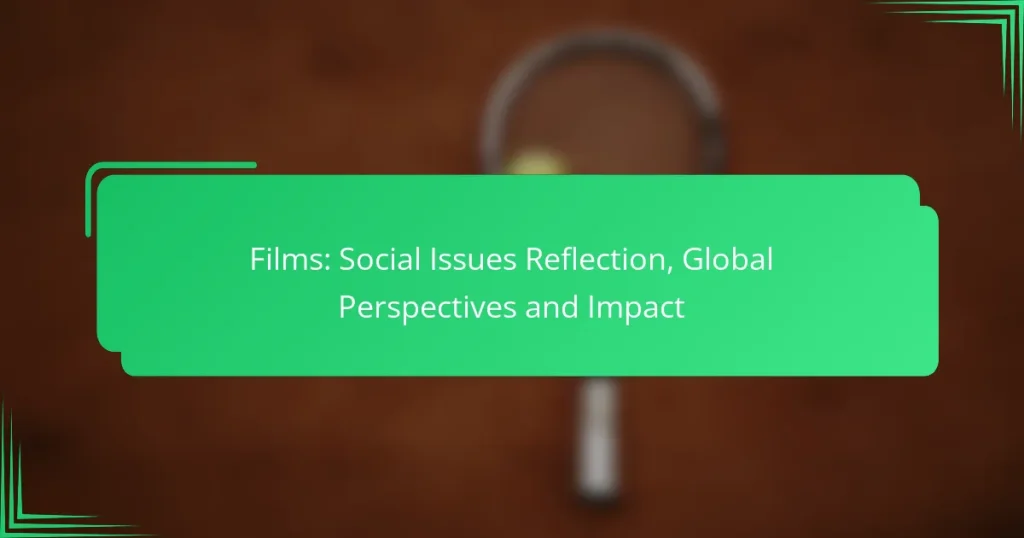Films are a compelling medium for exploring and reflecting on social issues, offering insights into cultural contexts and igniting discussions about critical topics such as race, poverty, and inequality. By weaving narratives that highlight injustices, filmmakers can inspire audiences to confront these challenges and advocate for social change, ultimately shaping perceptions and fostering awareness on a global scale.

How Do Films Address Social Issues Globally?
Films serve as powerful tools for addressing social issues by reflecting cultural contexts and sparking conversations around topics like race, poverty, and inequality. Through storytelling, filmmakers can highlight injustices and encourage audiences to engage with these critical global challenges.
Films as a Reflection of Cultural Context
Films often mirror the cultural contexts in which they are created, showcasing societal norms, values, and struggles. This reflection allows audiences to gain insights into different lifestyles and issues faced by various communities around the world.
For instance, a film set in a specific region may depict local customs and social challenges, making it relatable for those familiar with that culture while educating others. By portraying real-life situations, filmmakers can foster empathy and understanding among diverse audiences.
Case Studies: ’12 Years a Slave’ and Racial Injustice
’12 Years a Slave’ is a poignant example of how films can address racial injustice. Based on a true story, it portrays the harrowing experiences of Solomon Northup, a free Black man kidnapped and sold into slavery in the United States. The film highlights the brutal realities of slavery and its lasting impact on society.
This film not only raises awareness about historical injustices but also prompts discussions about ongoing racial issues. By presenting such narratives, filmmakers can challenge viewers to confront uncomfortable truths and advocate for change.
‘The Pursuit of Happyness’ and Economic Struggles
‘The Pursuit of Happyness’ illustrates the challenges of economic hardship through the true story of Chris Gardner, a struggling salesman who becomes homeless while raising his son. This film captures the essence of perseverance in the face of financial adversity, resonating with many who face similar struggles.
By showcasing the realities of poverty and the pursuit of the American Dream, the film encourages viewers to reflect on economic disparities and the importance of support systems. It serves as a reminder that success often requires resilience and determination, even amidst overwhelming challenges.

What Impact Do Films Have on Social Change?
Films can significantly influence social change by shaping perceptions, raising awareness, and inspiring action. Through storytelling, they highlight pressing social issues and encourage audiences to engage with these topics on a deeper level.
Raising Awareness Through Storytelling
Storytelling in films serves as a powerful tool for raising awareness about social issues. By presenting narratives that resonate emotionally, filmmakers can draw attention to topics such as poverty, discrimination, and environmental concerns. For example, films like “12 Years a Slave” and “The Pursuit of Happyness” have brought historical injustices and economic struggles to the forefront of public consciousness.
Moreover, documentaries often provide factual insights into social issues, helping viewers understand the complexities involved. This combination of emotional engagement and factual information can motivate audiences to learn more and take action.
Influencing Public Opinion and Policy
Films can shape public opinion by framing social issues in a relatable way, often leading to shifts in societal attitudes. When a film portrays a specific issue, it can challenge stereotypes and encourage empathy among viewers. For instance, movies like “Philadelphia” and “Brokeback Mountain” have played crucial roles in changing perceptions about [censured] rights.
Additionally, films can influence policymakers by highlighting social issues that require legislative attention. When a film gains popularity, it can lead to increased public discourse, prompting lawmakers to address the issues depicted. Advocacy groups often leverage the visibility of films to push for policy changes, making cinema a vital part of social activism.

Which Films Highlight Gender Equality Issues?
Several films effectively highlight gender equality issues by showcasing women’s struggles and triumphs in various contexts. These films not only entertain but also provoke thought and inspire change regarding gender roles and equality.
‘The Help’ and Intersectional Feminism
‘The Help’ explores the lives of African American maids in the 1960s South, illustrating the intersection of race and gender. The film emphasizes how systemic racism and sexism affect women’s lives, particularly those in marginalized communities.
By focusing on the stories of these women, ‘The Help’ sheds light on the importance of solidarity among women of different backgrounds. It encourages viewers to recognize and address the unique challenges faced by women at the intersection of multiple identities.
‘Hidden Figures’ and Women’s Contributions in STEM
‘Hidden Figures’ tells the inspiring true story of three African American women who played crucial roles at NASA during the Space Race. The film highlights their contributions to science, technology, engineering, and mathematics (STEM) while facing racial and gender discrimination.
This film serves as a reminder of the significant yet often overlooked contributions of women in STEM fields. It encourages educational institutions and employers to promote diversity and inclusion, ensuring that women’s voices and talents are recognized and valued in these critical areas.

How Do Documentaries Shape Perspectives on Global Issues?
Documentaries significantly influence how audiences perceive global issues by presenting factual narratives that evoke emotional responses and provoke critical thinking. Through storytelling and visual evidence, they can raise awareness, challenge misconceptions, and inspire action on pressing social matters.
Examples of Influential Documentaries
Several documentaries have left a lasting impact on public awareness and discourse. For instance, “An Inconvenient Truth” brought climate change to the forefront of global conversations, while “13th” highlighted systemic racism and mass incarceration in the United States. These films not only inform but also encourage viewers to engage with the issues presented.
Other notable examples include “Blackfish,” which raised awareness about the ethical implications of keeping orcas in captivity, and “The Act of Killing,” which explored the Indonesian mass killings of 1965-66 through the eyes of the perpetrators. Each of these films has sparked discussions and debates, demonstrating the power of documentaries to shape societal perspectives.
Documentary Impact on Activism
Documentaries can serve as powerful catalysts for activism by mobilizing viewers to take action. They often provide a platform for marginalized voices and highlight injustices that may otherwise go unnoticed. For example, “Food, Inc.” has encouraged many to rethink their food choices and advocate for sustainable agricultural practices.
Moreover, documentaries can inspire grassroots movements and support existing campaigns. They often include calls to action, urging viewers to participate in initiatives or support organizations working towards change. However, it’s crucial for activists to ensure that the narratives presented are accurate and respectful, avoiding sensationalism that could undermine their cause.

What Are the Key Criteria for Evaluating Social Issue Films?
Key criteria for evaluating social issue films include authenticity, representation, narrative structure, and emotional engagement. These elements help assess how effectively a film portrays social issues and resonates with its audience.
Authenticity and Representation
Authenticity in social issue films refers to the accurate portrayal of the communities and issues depicted. It is crucial for filmmakers to engage with real-life experiences and perspectives, ensuring that the voices of those affected are represented. This can involve collaborating with individuals from the community or employing consultants to provide insight.
Representation matters significantly; it affects how audiences perceive social issues. Films should strive for diverse casting and storytelling that reflect the complexities of the issues at hand. For example, a film about immigration should include narratives from immigrants themselves rather than relying solely on external viewpoints.
Narrative Structure and Emotional Engagement
The narrative structure of a social issue film plays a vital role in how the story unfolds and impacts viewers. A well-crafted narrative often includes relatable characters, clear conflicts, and resolutions that encourage reflection. This structure can help audiences connect emotionally with the subject matter, making the issues more tangible and urgent.
Emotional engagement is essential for driving awareness and prompting action. Filmmakers should consider using storytelling techniques that evoke empathy, such as personal testimonies or dramatic reenactments. Balancing factual information with compelling narratives can enhance the film’s impact, encouraging viewers to reflect on the social issues presented and consider their own roles in addressing them.

How Are Films Used in Education to Discuss Social Issues?
Films serve as powerful tools in education to explore and discuss social issues, providing visual narratives that enhance understanding and empathy. By integrating cinematic content, educators can engage students in critical conversations about topics such as inequality, justice, and human rights.
Incorporating Films into Curriculum
Incorporating films into the curriculum involves selecting relevant movies that align with educational goals and social themes. Educators should consider films that not only entertain but also provoke thought and discussion, such as documentaries or dramas that highlight social justice issues.
When integrating films, it’s essential to provide context before screenings. This can include background information on the issues presented, discussion questions, and post-viewing activities that encourage deeper analysis. For instance, a film about climate change can be paired with data on local environmental impacts.
Film Screenings and Community Discussions
Film screenings can be organized within educational institutions or community centers to foster discussions around social issues. These events create a platform for diverse voices and perspectives, allowing participants to share their thoughts and experiences related to the film’s themes.
To maximize engagement, facilitators should prepare discussion prompts and encourage respectful dialogue. It’s beneficial to include a variety of stakeholders, such as students, teachers, and community members, to enrich the conversation. Additionally, follow-up activities like workshops or forums can help translate discussions into actionable community initiatives.


